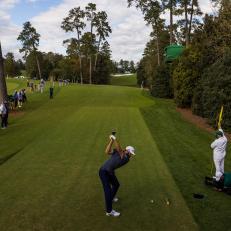The Shots You Need At Augusta
Jim Nantz calls the Masters a tradition unlike any other for several reasons, but the most important is the golf course. At 7,435 yards, it's widely believed that Augusta National is a bomber's paradise, though the green jackets of Mike Weir and Zach Johnson question that assertion. Alister MacKenzie's layout annually doles birdies in bunches and snowmen or worse, and that it's the only fixed venue in major-championship golf somehow heightens its familiarity and mystery.To get a better idea of what it takes to navigate the course, we conducted exit interviews. With the exceptions of 2013 champion Adam Scott and Henrik Stenson, the following statements were all recorded on the practice putting green at Harbour Town Golf Linkson Hilton Head Island in the days immediately after last year's Masters. This PGA Tour stop has its tradition unlike any other: It's the place where players finally decompress, exhale and talk about what it's really like to play Augusta. For most, the shots they needed are the shots they wished they'd had.
HENRIK STENSON
BEST FINISH / T-17 IN 2007 AND 2008Other than the bullet-straight 400-yard drive, there are two shots I think are most important in the Masters. The first is pitching and/or chipping off really tight lies and into the grain. That's so difficult, and it's the shot so many guys dread most. The time of year makes it worse, too. Sometimes there hasn't been much growth, so there's even less grass under the ball. If you have a 15-yard pitch, and the pin is five yards over a bunker with the ground sloping away, it's almost impossible to get the ball really close. I'd fancy it off a tee peg, but with the lies you normally get, that shot can be quite intimidating. You see guys putting, or chipping with a rescue club, or going with the lob shot. But nothing is easy, especially if you short-side yourself. A great example of that is if you miss the 13th green to the left, in that little dip. You have to come up and over the ridge in front of you, then let the ball run down the slope. It's so delicate, particularly when the pin is front-left or back-left. The difference between glory and disaster is very small.
ADAM SCOTT
DEFENDING CHAMPIONYou need a simple, confident chip. It's a tight lie all week, so if you can be a bit more shallow you get a better margin for error. Just to be able to tap it up there to a couple of feet is a really nice feeling that keeps you going.
BRIAN GAY
T-38 IN 2013The golf course changes a lot over the course of the tournament. The grass around the greens is lush leading in, then they lower the mowers on the weekend. Spinning lob shots are a must. I find it real hard to bump chips into the hills because the grass is always mowed with the grain back at you.
LEE WESTWOOD
RUNNER-UP IN 2010You need a hard draw off the tee on holes 10 and 13. Not just a little draw.
RYAN MOORE
T-13 IN 2005You can't get away playing your stock shot. Not going to just show up and play a baby cut all day. There are so few level stances that you're always forced to play the shot that the course is allowing you. On 10 and 13, the ball is going to be above your feet, and yet you're going to need to hit a high cut to hold the green. Tough to hit a fade off a severe hook lie. You never have these lies on the range, so your only chance to practice them is on the course.
NICOLAS COLSAERTS
MISSED CUT IN 2013Guys who can hit their long irons high have an edge. You need a ball that drops from the moon on holes 4, 5, 7 and 15. Around the greens, you need short little flops that bounce gently with the quietest responses possible.
ZACH JOHNSON
WON IN 2007My first Masters was in 2005, and I left frustrated. It was wet that year, but the greens were still lightning fast. I played with Mark O'Meara, who obliterated me [Johnson had a first-round 81 to O'Meara's even-par 72], and I didn't feel I hit it any worse than he did. In 2006, I made the cut and got my confidence. It's all chipping and short game. You don't try to make putts. You pick the highest line possible, and then maybe go a little higher. Then I won in 2007, so I guess you could say it took me two years to figure out the place.
ROBERT GARRIGUS
T-38 IN 2013The greens run away on every side, so you really need to control your approaches. And it's surprisingly difficult to control your ball out of that first cut. The grain is always going toward the tee box, so you get grass right between the club and the grooves. The grass is sticky and mowed at just that height where you need to present the clubface perfectly. Seemed like I had three-quarter yardages in all week, and to hit those correctly you can't get too steep with your attack angle. And the 12th is the hardest hole in golf. You can never learn on 12. You can play with guys who've played 20 Masters, and they still get fooled by the wind there. All you can do is suck it up and try to hit the shot, and that's what makes the course so great.
BO VAN PELT
T-8 IN 2011Every year this course makes you appreciate the fine line between a good and bad shot. Chipping, you want to skip the ball into the green, but you can't have it come in hot. I used my 52-degree to bump it all week. Really need to have that shot tuned. A chip that goes eight feet by the cup at a regular tour event might go 30 feet by.
JASON DAY
T-8 IN 2011You've got to tamp that adrenaline. Feels like every shot at Augusta is the biggest shot of your life.






